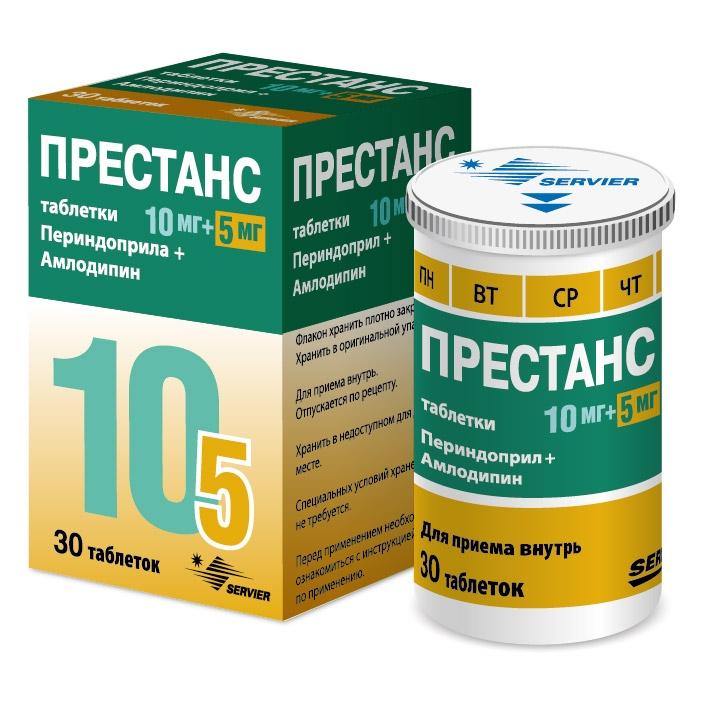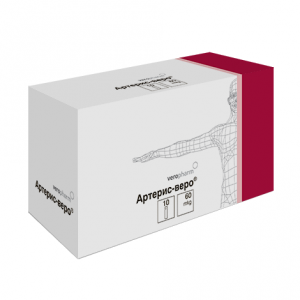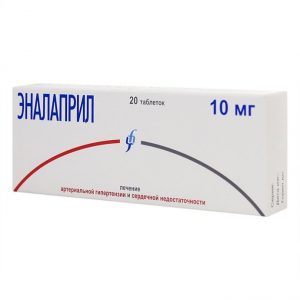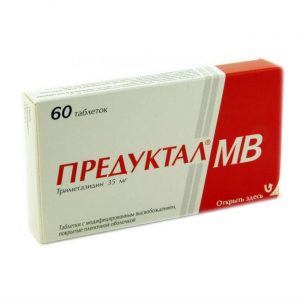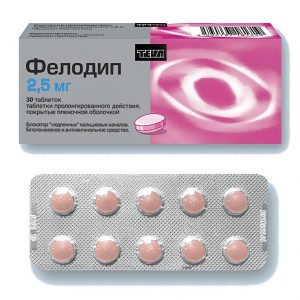Description
Latin name
Prestans
Release form
Tablets.
Packaging
In a polymer bottle with a dispenser of 30 tablets. In a cardboard box 1 polymer bottle.
Pharmacological action
Prestanz tablets – combined antihypertensive and antianginal drug.
Perindopril Perindopril is an inhibitor of the enzyme that converts angiotensin I to angiotensin II (an ACE inhibitor). ACE, or kininase II, is an exopeptidase that carries out both the conversion of angiotensin I into a vasoconstrictor substance angiotensin II, and the destruction of bradykinin, which has a vasodilating effect, to an inactive heptapeptide. Since ACE inactivates bradykinin, ACE suppression is accompanied by an increase in the activity of both the circulating and tissue kallikrein-kinin systems, while the prostaglandin system is also activated. Perindopril has a therapeutic effect due to the active metabolite, perindoprilat. Other metabolites do not inhibit ACE in vitro.
– Arterial Hypertension Perindopril is a drug for the treatment of arterial hypertension of any severity. Against the background of its use, there is a decrease in both systolic and diastolic blood pressure in the supine and standing position. Perindopril reduces OPSS, which leads to a decrease in high blood pressure and an improvement in peripheral blood flow without a change in heart rate. As a rule, taking perindopril increases renal blood flow, the glomerular filtration rate does not change. The antihypertensive effect of the drug reaches a maximum 4-6 hours after a single oral administration and persists for 24 hours. Antihypertensive effect 24 hours after a single oral administration is about 87-100% of the maximum antihypertensive effect. Lowering blood pressure is achieved quite quickly. The therapeutic effect occurs less than 1 month after the start of therapy and is not accompanied by tachycardia. Discontinuation of treatment does not cause withdrawal syndrome. Perindopril has a vasodilating effect, helps to restore the elasticity of large arteries and the structure of the vascular wall of small arteries, and also reduces left ventricular hypertrophy. Stable IHD. The effectiveness of perindopril in patients (12,218 patients over 18 years of age) with stable IHD without clinical symptoms of chronic heart failure was studied in 4-year study (EUROPA). 90% of the study participants had previous acute myocardial infarction or coronary revascularization. Therapy with perindopril tertbutylamine at a dose of 8 mg / day (equivalent to 10 mg of perindopril arginine) led to a significant decrease in the absolute risk of complications by 1.9%, in patients who had previous myocardial infarction or coronary revascularization, the decrease in absolute risk was 2.2% compared with the placebo group. Amlodipine Amlodipine is a slow calcium channel blocker, a derivative of the dihydropyridine series. Amlodipine inhibits the transmembrane transition of calcium ions to cardiomyocytes and smooth muscle cells of the vascular wall. The antihypertensive effect of amlodipine is due to a direct effect on the smooth muscle cells of the vascular wall. It was found that amlodipine causes the expansion of peripheral arterioles, reducing OPSS (afterload), since heart rate does not change, and myocardial oxygen demand decreases. It causes the expansion of coronary arteries and arterioles in both ischemic and intact zones. In patients with Prinzmetal angina, coronary blood flow improves. In patients with arterial hypertension, taking amlodipine 1 time / day provides a clinically significant decrease in blood pressure when standing and lying down for 24 hours. The antihypertensive effect develops slowly, and therefore the development of acute arterial hypotension is uncharacteristic. In patients with angina pectoris, taking amlodipine 1 time / day increases exercise tolerance, delays the onset of angina attack and ischemic depression of the ST segment, and also reduces the frequency of angina attacks and consumption of nitroglycerin (short-acting forms). Amlodipine does not affect the lipid profile and does not cause changes in lipid-lowering blood plasma parameters. The drug can be used in patients with concomitant bronchial asthma, diabetes mellitus and gout. The efficacy and safety of the use of amlodipine at a dose of 2.5-10 mg / day, an ACE inhibitor lisinopril at a dose of 10-40 mg / day and a thiazide diuretic chlortalidone at a dose of 12.5-25 mg / day as a first-line drug was studied in a 5-year ALLHAT study ( involving 33,357 patients 55 years of age and older) in patients with mild or moderate arterial hypertension and at least one of the additional risk factors for coronary complications, such as myocardial infarction or stroke, more than 6 months before research inclusion tion, or other confirmed cardiovascular disease of atherosclerotic origin, diabetes mellitus HDL cholesterol less than 35 mg / dl left ventricular hypertrophy according to ECG or smoking echocardiography. The main criterion for assessing effectiveness is a combined indicator of the frequency of deaths from coronary heart disease and the frequency of non-fatal myocardial infarction. There were no significant differences between the groups of amlodipine and chlortalidone according to the main evaluation criterion. The frequency of heart failure in the amlodipine group was significantly higher than in the chlortalidone group – 10.2% and 7.7%, respectively, the total mortality rate in the amlodipine and chlortalidone group did not differ significantly. Perindopril and amlodipine Effectiveness with prolonged use of amlodipine in combination with perindopril and atenolol in combination with bendroflumethiazide in patients aged 40 to 79 years with arterial hypertension and at least 3 of the additional risk factors: left ventricular hypertrophy according to ECG or echocardiography type 2 diabetes mellitus peripheral arterial atherosclerosis previous stroke or transient ischemic attack male sex age 55 years and older with microalbuminuria or proteinuria smoking total m cholesterol / HDL cholesterol 6 early development of coronary heart disease in immediate families was studied in the ASCOT-BPLA study. The main criterion for assessing effectiveness is a combined indicator of the frequency of non-fatal myocardial infarction (including painless) and lethal outcomes of coronary heart disease. Complication rate prescribed by the main evaluation criterion, in the amlodipine / perindopril group was 10% lower than in the atenolol / bendroflumethiazide group, however, this difference was not statistically significant. In the amlodipine / perindopril group, there was a significant decrease in the frequency of complications provided for by additional performance criteria (except for fatal and non-fatal heart failure).
Indications
Arterial hypertension.
– CHD: stable angina pectoris in patients who require perindopril and amlodipine therapy.
Contraindications
Perindopril: – History of angioedema (Quincke’s edema) (including with other ACE inhibitors).
– Hereditary / idiopathic angioedema.
– Age under 18 years of age (efficacy and safety not established).
– Hypersensitivity to perindopril or other ACE inhibitors.
amlodipine: – Severe arterial hypotension (systolic blood pressure less than 90 mm Hg).
– Obstruction of the exit tract of the left ventricle (for example, severe aortic stenosis).
– Unstable angina (with the exception of Prinzmetal angina).
– Age under 18 years of age (efficacy and safety not established).
– Hypersensitivity to amlodipine or other dihydropyridine derivatives.
Prestanz: – Renal failure (CC less than 60 ml / min).
– Age under 18 years of age (efficacy and safety not established).
– Hereditary lactose intolerance, lactase deficiency and glucose / galactose malabsorption syndrome.
– Hypersensitivity to excipients that make up the drug.
Precautions:
Renal artery stenosis (including bilateral).
– The only functioning kidney.
– Liver failure.
– Renal failure.
– Systemic diseases of the connective tissue (including systemic lupus erythematosus, scleroderma).
– Therapy with immunosuppressants, allopurinol, procainamide (risk of neutropenia, agranulocytosis).
– Reduced bcc (intake of diuretics, salt-free diet, vomiting, diarrhea).
– Atherosclerosis.
– Cerebrovascular disease.
– Renovascular hypertension.
– Diabetes mellitus.
– Chronic heart failure.
– Use of dantrolene, estramustine, potassium-sparing diuretics, potassium preparations, potassium-containing salt substitutes and lithium preparations.
– Hyperkalemia.
– Surgery / General Anesthesia.
– Old age.
– Hemodialysis using high flow membranes (e.g. AN69 ®).
– Desensitizing therapy.
– Apheresis LDL.
– Aortic stenosis / mitral stenosis / hypertrophic cardiomyopathy.
– Patients of the Negroid race.
Use during pregnancy and lactation
The drug is contraindicated in pregnancy.
Unless a Prestance therapy is necessary for health reasons, when planning pregnancy, the drug should be discontinued and other antihypertensive drugs prescribed for use during pregnancy should be prescribed. When pregnancy occurs, you should immediately stop taking Prestans and, if necessary, prescribe another therapy.
It is known that the effects of ACE inhibitors on the fetus in the second and third trimesters of pregnancy can lead to impaired development (impaired renal function, oligohydramnios, delayed ossification of the bones of the skull) and the development of complications in the newborn (renal failure, hypotension, hyperkalemia). If the patient received ACE inhibitors in the II or III trimesters of pregnancy, it is recommended to conduct an ultrasound examination of the fetus to assess the condition of the skull and kidney function.
Newborns whose mothers received ACE inhibitors during pregnancy, need careful medical supervision because of the risk of developing arterial hypotension, oliguria and hyperkalemia. Limited data on the use of amlodipine and other slow calcium channel blockers during pregnancy indicate that the drug does not adversely affect the fetus. However, there is a risk of prolonged labor.
It is not recommended to take Prestanz during lactation due to the lack of appropriate clinical experience with perindopril and amlodipine, both as monotherapy and in combination. If you need to take the drug, you should stop breastfeeding.
Composition
1 tablet contains: Perindopril arginine 10 mg,
– Which corresponds to the content of perindopril 679 mg.
– Which corresponds to the content of amlodipine 5 mg.
Excipients: Microcrystalline cellulose, lactose monohydrate, magnesium stearate, anhydrous colloidal silicon dioxide.
Dosage and administration
The drug is administered orally, 1 tablet 1 time / day, preferably in the morning before meals. The dose of Prestanz is selected after titration of doses of the individual components of the drug: perindopril and amlodipine in patients with arterial hypertension and stable angina pectoris.
If necessary, the dose of Prestanz may be changed based on individual selection of doses of the individual components: 5 mg of perindopril + 5 mg of amlodipine or 5 mg of perindopril + 10 mg of amlodipine + 10 mg of perindopril + 5 mg of amlodipine or 10 mg of perindopril + 10 mg amlodipine.
Prestanzation in doses of 10 mg perindopril + 10 mg amlodipine is the maximum daily dose that should not be exceeded.
Elimination of perindoprilat in elderly patients and patients with renal failure is slowed down. Therefore, in such patients, it is necessary to regularly monitor the concentration of creatinine and potassium in the blood plasma. Prestanz can be prescribed to patients with QC? 60 ml / min. Prestanz is contraindicated in patients with CC <60 ml / min. Such patients are recommended an individual selection of doses of perindopril and amlodipine. A change in the concentration of amlodipine in blood plasma does not correlate with the severity of renal failure. Caution should be exercised when prescribing Prestanz to patients with hepatic insufficiency due to the lack of recommendations for dosing the drug in such patients. Prestanz should not be prescribed to children and adolescents under 18 years of age due to a lack of data on the efficacy and safety of perindopril and amlodipine in these patient groups, both as monotherapy and in combination therapy. Side effects of From the hemopoietic system: very rarely – leukopenia, neutropenia, agranulocytosis, pancytopenia, thrombocytopenia, hemolytic anemia in patients with congenital deficiency of glucose-6-phosphate dehydrogenase, decreased hemoglobin and hematogen levels. Allergic reactions: infrequently – urticaria. Metabolic disorders: infrequently – weight gain, weight loss. Very rarely – hyperglycemia. From the side of the central nervous system: often – drowsiness, dizziness, headache, paresthesia infrequently – insomnia, lability of mood, sleep disturbance, tremor, hypesthesia very rarely – peripheral neuropathy, confusion. From the side of the organ of vision: often – visual disturbances. On the part of the hearing organ: often – tinnitus. From the cardiovascular system: often – palpitations, flushing of the face, a marked decrease in blood pressure. Infrequently – fainting. Rarely – pain behind the sternum. Very rarely – angina pectoris, myocardial infarction, possibly due to an excessive decrease in blood pressure in patients at high risk, arrhythmias (including bradycardia, ventricular tachycardia and atrial fibrillation), stroke, possibly due to an excessive decrease in blood pressure in patients from high risk, vasculitis. From the respiratory system: often – shortness of breath, cough infrequently – rhinitis, bronchospasm very rarely – eosinophilic pneumonia. From the digestive system: often – abdominal pain, nausea, vomiting, dyspepsia, taste disturbance, diarrhea, constipation infrequently – constipation, dry oral mucosa rarely – elevated bilirubin levels are very rare – pancreatitis, gingival hyperplasia, gastritis, hepatitis, cholestatic jaundice, cytolytic or cholestatic hepatitis, increased activity of liver enzymes ACT, ALT (most often in combination with cholestasis). From the skin: often – itching, rash infrequently – angioedema of the face, limbs, lips, mucous membranes, tongue, glottis and / or larynx, alopecia, hemorrhagic rash, photosensitivity, increased sweating very rarely – Quincke’s edema, multiform erythema, Stevens-Johnson syndrome. From the musculoskeletal system: often – muscle spasms infrequently – arthralgia, myalgia, back pain. From the kidneys and urinary tract: infrequently – impaired urination, nocturia, rapid urination, renal failure is very rare – severe renal failure. From the reproductive system: infrequently – impotence, gynecomastia. On the part of the body as a whole: often – peripheral edema, asthenia, increased fatigue. Infrequently – chest pain, malaise. Laboratory indicators: unspecified frequency – increased serum urea and creatinine, hyperkalemia. Drug Interaction Perindopril: – Recommended drug combinations: ACE inhibitors reduce urinary potassium loss caused by diuretics. Potassium-sparing diuretics (for example, spironolactone, triamterene, amiloride), potassium preparations and potassium-containing edible salt substitutes can lead to a significant increase in serum potassium. If the combined use of ACE inhibitor and the above agents (in case of confirmed hypokalemia) is required, Caution should be exercised and regular monitoring of blood plasma potassium and ECG parameters. Concomitant use of lithium preparations and ACE inhibitors may result in a reversible increase in plasma lithium content and associated toxic effects. Concomitant use of perindopril and lithium preparations is not recommended. If such therapy is required, regular monitoring of the plasma lithium content is required. The combined use of Prestance with estramustine is accompanied by an increased risk of angioneurotic edema. A combination of medicines that require special attention: The administration of NSAIDs, including high doses of acetylsalicylic acid (greater than 3 g / day), can lead to a decrease in diuretic, natriuretic and antihypertensive effects. With a significant loss of fluid, as well as in elderly patients, acute renal failure (due to a decrease in glomerular filtration rate) may develop. Patients should compensate for fluid loss and carefully monitor renal function at the beginning of treatment. ACE inhibitors can enhance the hypoglycemic effect of insulin and sulfonylurea derivatives in patients with diabetes mellitus. The development of hypoglycemia is very rare (probably due to an increase in glucose tolerance and a decrease in insulin requirement). A combination of medicines requiring attention: Patients receiving diuretics (thiazide and loop), especially with excess fluid and / or electrolytes removal the beginning of ACE inhibitor therapy may have a significant decrease in blood pressure, the risk of which can be reduced by eliminating diuretics, the introduction of an increased amount of liquid and / or sodium chloride, and prescribing perindopril in a low dose with a further gradual increase. Sympathomimetics can attenuate the hypotensive effect of ACE inhibitors. When appointing ACE inhibitors, incl. perindopril, patients receiving injectable gold preparations (sodium aurothiomalate) were noted with nitrate-like reactions (facial skin hyperemia, nausea, vomiting, arterial hypotension). Concomitant use with allopurinol ACE inhibitors, cytostatic and immunosuppressive agents, corticosteroids (with systemic use) and procainamide may be associated with an increased risk of leukopenia. Co-administration of ACE inhibitors and agents for general anesthesia may increase the antihypertensive effect. Amlodipine: – Recommended drug combinations: In laboratory animals, cases of lethal ventricular fibrillation were noted on the background of verapamil and / / administration of dantrolene. Extrapolating the available data, the combined use of dantrolene and amlodipine should be avoided. Combination of drugs requiring special attention: When co-administered with CYP3A4 cytochrome inducers (rifampicin, Hypericum periwinkle, anticonvulsants such as carbamazepine, phenobarbital, phenytoin, phosphenitolysis, methidine reduction roast. Caution should be exercised when co-administering amlodipine and inducers of microsomal oxidation and adjusting the dose of amlodipine if necessary. When used concomitantly with cytochrome CYP3A4 inhibitors (itraconazole, ketoconazole) may increase the plasma concentration of amlodipine and increase the risk of side effects. Caution should be exercised when co-administering amlodipine and itraconazole or ketoconazole, adjusting the dose of amlodipine, if necessary. hypotension and worsening of the course of chronic heart failure in patients with uncontrolled or latent chronic heart failure insufficiency (amplification of negative inotropic effect). Beta-blockers can also reduce excessive reflex cardiac sympathetic activation amid concomitant chronic heart failure. Other combinations of medicines: The safety of the use of amlodipine when combined in combination with thiazide diuretics, beta-blockers, ACE inhibitors, nitrates in prolonged dosage forms, nitroglycerin (for sublingual use), digomorithin (for sublingual use), noted , magnesium hydroxide), simethicone, cimetidine, NSAIDs, antibiotics and hypoglycemic agents for oral administration. In addition, special studies have shown no interaction of the following drugs with amlodipine: – When amlodipine and cimetidine were co-administered, the pharmacokinetic parameters of amlodipine did not change. – When combined with amlodipine and sildenafil, no increase in the antihypertensive effect of each drug was observed. – Grapefruit juice: a study involving 20 healthy volunteers showed that taking 240 ml of grapefruit juice together with a single dose of amlodipine (10 mg orally) did not have a significant effect on the pharmacokinetics of amlodipine. Amlodipine does not affect the pharmacokinetics of the following drugs: – Atorvastatin: administration of repeated doses of amlodipine 10 mg in combination with atorvastatin at a dose of 80 mg does not significantly alter the equilibrium pharmacokinetic parameters of atorvastatin. – Digoxin: co-administration of amlodipine and digoxin is not accompanied by a change in serum digoxin content and renal clearance of digoxin in healthy volunteers. – Warfarin: In healthy male volunteers receiving warfarin, the addition of amlodipine did not have a significant effect on the change in prothrombin time caused by warfarin. – Cyclosporine: Amlodipine has no significant effect on the pharmacokinetic parameters of cyclosporine. – A combination of medicines that require special attention: Increased antihypertensive effect may occur when co-administered with baclofen. The blood pressure and function of the kidneys should be monitored, if necessary, the dose of amlodipine should be adjusted. – A combination of drugs that require attention: Antihypertensives (e.g. beta-blockers) and vasodilators can enhance the hypotensive effect of perindopril and amlodipine. Caution should be exercised when co-administered with nitroglycerin, other nitrates, or other vasodilators, as this may further reduce blood pressure. Corticosteroids (mineral and glucocorticoids), tetracosactide reduce the antihypertensive effect (retention of fluid and sodium ions due to the action of corticosteroids). Alpha blockers (prazosin, alfuzosin, doxazosin, tamsulosin, terazosin) increase the antihypertensive effect and increase the risk of orthostatic hypotension. Amifostine may potentiate the hypotensive effect of amlodipine. Tricyclic antidepressants / neuroleptics / agents for general anesthesia increase the antihypertensive effect and increase the risk of orthostatic hypotension. Overdose There is no information on an overdose of Prestance. Amlodipine Information on overdose on amlodipine is limited. – Symptoms: pronounced decrease in blood pressure with possible development of reflex tachycardia and excessive peripheral vasodilation (risk of developing severe and persistent arterial hypotension, including with the development of shock and lethal outcome). – Treatment: gastric lavage, appointment of activated charcoal (especially in the first 2 h after overdose), maintenance of cardiovascular function, elevated limb position, control of BCC and diuresis, symptomatic and supportive therapy, in / in administration of calcium gluconate. Dialysis is ineffective. With a significant decrease in blood pressure, the patient should be monitored under cardiac OIT. In the absence of contraindications, vasoconstrictors can be used to restore vascular tone and blood pressure. Perindopril: Limited data are available on perindopril overdose. – Symptoms: significant decrease in blood pressure, shock, electrolyte disorders, renal failure, hyperventilation, tachycardia, palpitations, bradycardia, dizziness, anxiety and cough. – Treatment: with a significant decrease in blood pressure, the patient should be placed in a supine position with his legs elevated, and if necessary, correction of hypovolemia (eg, infusion of 0.9% sodium chloride solution) should be performed. It is also possible to administer angiotensin II and / or catecholamines. With hemodialysis, perindopril can be removed from the systemic circulation. For therapy-resistant bradycardia, an artificial rhythm driver may be required. Dynamic control of the physical state, concentration of creatinine and blood plasma electrolytes is required. Emergency measures are reduced to eliminating the drug from the body: gastric lavage and / or the appointment of activated charcoal followed by the restoration of the hydro-electrolyte balance. Storage conditions No special storage conditions are required. Keep the bottle tightly closed. – Keep out of the reach of children. – Do not use after the expiration date. Expiration 2 years. Deystvuyuschee substances amlodipine, Perindopril Terms pharmacy leave with prescription dosage form dosage form tablets Servye, France
